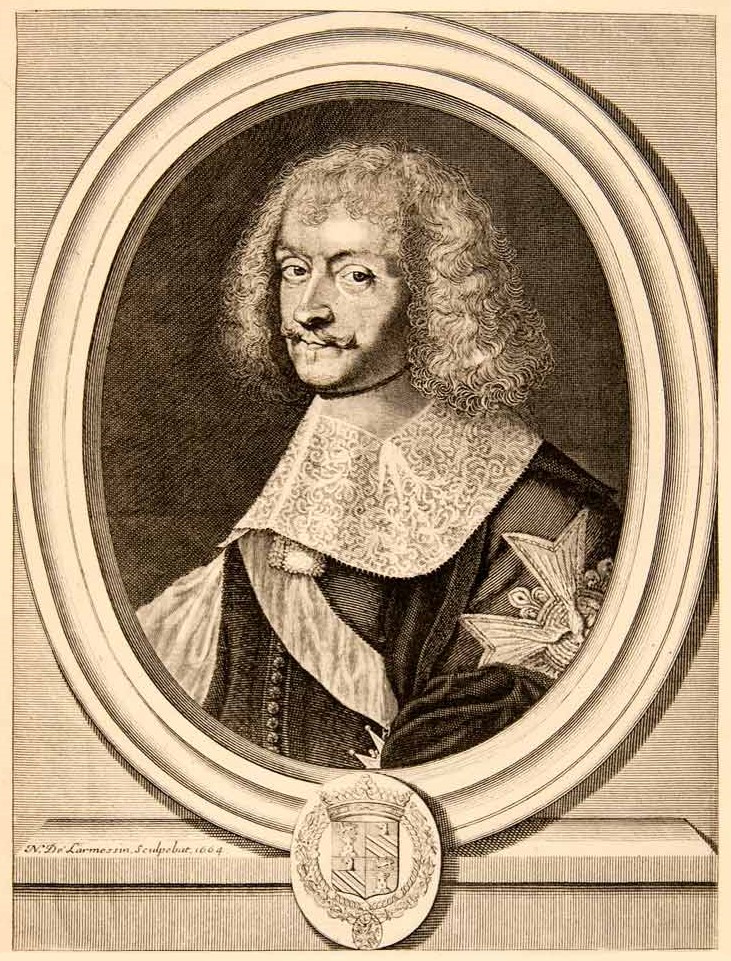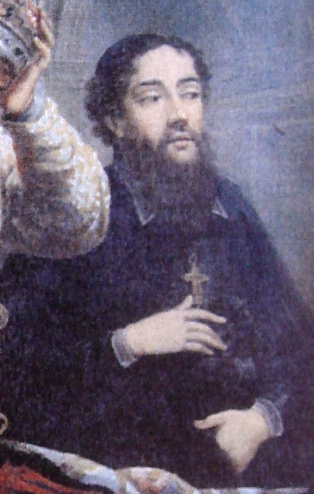|
Hugues De Lionne
Hugues de Lionne (11 October 1611 – 1 September 1671) was a French statesman. He was born in Grenoble, of an old family of Dauphiné. Early trained for diplomacy, he fell into disgrace under Cardinal Richelieu, but his remarkable abilities attracted the notice of Cardinal Mazarin, who sent him as secretary of the French embassy to the congress of Munster, and, in 1642, on a mission to the pope. In 1646 he became secretary to the queen regent Anne of Austria; in 1653 obtained high office in the kings household; and in 1654 was ambassador extraordinary at the election of Pope Alexander VII. On the death of Ferdinand III, Hugues co-led the French effort to select an Emperor outside the Habsburg family. He and the Cardinal cultivated relationships with German nobility, including Franz Egon of Fürstenberg, prime minister of Cologne, and his brother Wilhelm. With their help, Hugues was instrumental in forming the league of the Rhine, by which Austria was cut off from the Sp ... [...More Info...] [...Related Items...] OR: [Wikipedia] [Google] [Baidu] |
Spanish Netherlands
Spanish Netherlands (Spanish: Países Bajos Españoles; Dutch: Spaanse Nederlanden; French: Pays-Bas espagnols; German: Spanische Niederlande.) (historically in Spanish: ''Flandes'', the name "Flanders" was used as a ''pars pro toto'') was the Habsburg Netherlands ruled by the Spanish branch of the Habsburgs from 1556 to 1714. They were a collection of States of the Holy Roman Empire in the Low Countries held in personal union by the Spanish Crown (also called Habsburg Spain). This region comprised most of the modern states of Belgium and Luxembourg, as well as parts of northern France, the southern Netherlands, and western Germany with the capital being Brussels. The Army of Flanders was given the task of defending the territory. The Imperial fiefs of the former Burgundian Netherlands had been inherited by the Austrian House of Habsburg from the extinct House of Valois-Burgundy upon the death of Mary of Burgundy in 1482. The Seventeen Provinces formed the core of the Habsburg N ... [...More Info...] [...Related Items...] OR: [Wikipedia] [Google] [Baidu] |
China
China, officially the People's Republic of China (PRC), is a country in East Asia. It is the world's most populous country, with a population exceeding 1.4 billion, slightly ahead of India. China spans the equivalent of five time zones and borders fourteen countries by land, the most of any country in the world, tied with Russia. Covering an area of approximately , it is the world's third largest country by total land area. The country consists of 22 provinces, five autonomous regions, four municipalities, and two Special Administrative Regions (Hong Kong and Macau). The national capital is Beijing, and the most populous city and financial center is Shanghai. Modern Chinese trace their origins to a cradle of civilization in the fertile basin of the Yellow River in the North China Plain. The semi-legendary Xia dynasty in the 21st century BCE and the well-attested Shang and Zhou dynasties developed a bureaucratic political system to serve hereditary monarchies, or dyna ... [...More Info...] [...Related Items...] OR: [Wikipedia] [Google] [Baidu] |
Siam
Thailand ( ), historically known as Siam () and officially the Kingdom of Thailand, is a country in Southeast Asia, located at the centre of the Mainland Southeast Asia, Indochinese Peninsula, spanning , with a population of almost 70 million. The country is Template:Borders of Thailand, bordered to the north by Myanmar and Laos, to the east by Laos and Cambodia, to the south by the Gulf of Thailand and Malaysia, and to the west by the Andaman Sea and the extremity of Myanmar. Thailand also shares maritime borders with Vietnam to the southeast, and Indonesia and India to the southwest. Bangkok is the nation's capital and largest city. Tai peoples migrated from southwestern China to mainland Southeast Asia from the 11th century. Greater India, Indianised kingdoms such as the Mon kingdoms, Mon, Khmer Empire and Monarchies of Malaysia, Malay states ruled the region, competing with Thai states such as the Kingdoms of Ngoenyang, Sukhothai Kingdom, Sukhothai, Lan Na and Ayuttha ... [...More Info...] [...Related Items...] OR: [Wikipedia] [Google] [Baidu] |
Paris Foreign Missions Society
The Society of Foreign Missions of Paris (french: Société des Missions Etrangères de Paris, short M.E.P.) is a Roman Catholic missionary organization. It is not a religious institute, but an organization of secular priests and lay persons dedicated to missionary work in foreign lands. The Society of Foreign Missions of Paris was established 1658–63. In 1659, instructions for establishment of the Paris Foreign Missions Society were given by Rome's Sacred Congregation for the Propagation of the Faith. This marked the creation of a missionary institution that, for the first time, did not depend on the control of the traditional missionary and colonial powers of Spain or Portugal. In the 350 years since its foundation, the institution has sent more than 4,200 missionary priests to Asia and North America. Their mission is to adapt to local customs and languages, develop a native clergy, and keep close contacts with Rome.Missions, p.4 In the 19th century, local persecutions of ... [...More Info...] [...Related Items...] OR: [Wikipedia] [Google] [Baidu] |
Artus De Lionne
Artus de Lionne (1655–1713), abbé and Bishop of Rosalie ''in partibus infidelium'', in Turkey, was a French missionary of the Paris Foreign Missions Society. He was a son of Louis XIV's Foreign Minister, Hugues de Lionne.''Rituals of majesty: France, Siam, and court spectacle in royal image-building at Versailles in 1685 and 1686'' Canadian Journal of History, Aug 1996 by Love, Ronald /ref> Biography Artus de Lionne was born in Rome in 1655. He first left for Siam as a missionary, in 1681. He returned to France in 1686, serving as translator to the embassy of the Siamese Kosa Pan to the court of Louis XIV.Smithies, Note 3, p.28 Artus de Lionne then returned to Siam with the Siamese embassy in 1687 on board the ships of the French ambassador Simon de la Loubère. He played a role in the negotiation between the French and Siamese sides during the 1688 Siamese Revolution, which resulted in the expulsion of the French forces. Artus de Lionne left Siam with General Desfarges fo ... [...More Info...] [...Related Items...] OR: [Wikipedia] [Google] [Baidu] |
Paris
Paris () is the capital and most populous city of France, with an estimated population of 2,165,423 residents in 2019 in an area of more than 105 km² (41 sq mi), making it the 30th most densely populated city in the world in 2020. Since the 17th century, Paris has been one of the world's major centres of finance, diplomacy, commerce, fashion, gastronomy, and science. For its leading role in the arts and sciences, as well as its very early system of street lighting, in the 19th century it became known as "the City of Light". Like London, prior to the Second World War, it was also sometimes called the capital of the world. The City of Paris is the centre of the Île-de-France region, or Paris Region, with an estimated population of 12,262,544 in 2019, or about 19% of the population of France, making the region France's primate city. The Paris Region had a GDP of €739 billion ($743 billion) in 2019, which is the highest in Europe. According to the Economist Intelli ... [...More Info...] [...Related Items...] OR: [Wikipedia] [Google] [Baidu] |
Sale Of Dunkirk
The Sale of Dunkirk took place on when Charles II of England sold his sovereign rights to Dunkirk and Fort-Mardyck to his cousin Louis XIV of France. Context Dunkirk was occupied by English forces of the Protectorate in 1658, when it was captured from Spain by Anglo-French forces following the Battle of the Dunes. The Spanish forces included the Royalist Army in Exile consisting of English, Scottish, and Irish Royalist Regiments: The English King's Guards (foot) under Wentworth; a Scottish regiment under Newburgh; The Marquis of Ormond's (Irish) Regiment under Richard Grace; The Duke of York's (Irish) Regiment under Muskerry; The Duke of Gloucester's (Irish) Regiment under Taaffe; and Farrell's (Irish) Regiment under Lisagh Farrell. The regiments (except, perhaps, Ormond's) were seriously understrength and were all under the overall command of James, Duke of York. There was also a small contingent of James' own Life Guards. The English part of the Anglo-French force included ... [...More Info...] [...Related Items...] OR: [Wikipedia] [Google] [Baidu] |
Treaty Of Aix-la-Chapelle (1668)
__NOTOC__ The Treaty of Aix-la-Chapelle or Aachen ended the War of Devolution between France and Spain. It was signed on 2 May 1668 in Aachen (french: Aix-la-Chapelle). Spain acceded on 7 May 1669. The treaty was mediated and guaranteed by the Triple Alliance of the Dutch Republic, England and Sweden at the First Congress of Aix-la-Chapelle. By the terms of the treaty, Louis XIV returned three cities, Cambrai (Kamerijk), Aire (Ariën aan de Leie), and Saint-Omer (Sint-Omaars) to Spain.Phillipson (1916), p. 222. He also returned the province of Franche-Comté. On the other hand, he kept Armentières (Armentiers), Bergues (Sint-Winoksbergen), Charleroi, Courtrai (Kortrijk), Douai (Dowaai), Furnes (Veurne), Lille (Rijsel), Oudenarde (Oudenaarde, Audenarde), and Tournai (Doornik). Lille, Armentières, Bergues and Douai were considered essential to reinforce France's vulnerable northern border and remain French to this day, while the retention of Tournai, Oudenarde, Courtrai, ... [...More Info...] [...Related Items...] OR: [Wikipedia] [Google] [Baidu] |
Treaty Of Breda (1667)
The Peace of Breda, or Treaty of Breda was signed in the Dutch city of Breda, on 31 July 1667. It consisted of three separate treaties between England and each of its opponents in the Second Anglo-Dutch War: the Dutch Republic, France, and Denmark–Norway. It also included a separate Anglo-Dutch commercial agreement. Negotiations had been in progress since late 1666 but were slow, as both sides tried to improve their positions. This changed after the French invasion of the Spanish Netherlands in late May, which the Dutch viewed as a more serious threat. War-weariness in England was increased by the June Raid on the Medway. Both factors led to a rapid agreement of terms. Prior to 1667, the Anglo-Dutch relationship had been dominated by commercial conflict, which the treaty did not end entirely. However, tensions decreased markedly and cleared the way for the 1668 Triple Alliance between the Dutch Republic, England and Sweden. With the brief anomaly of the 1672 to 1674 Third ... [...More Info...] [...Related Items...] OR: [Wikipedia] [Google] [Baidu] |
Minister Of Foreign Affairs (France)
The Ministry for Europe and Foreign Affairs () is the ministry of the Government of France that handles France's foreign relations. Since 1855, its headquarters have been located at 37 Quai d'Orsay, close to the National Assembly. The term Quai d'Orsay is often used as a metonym for the ministry. Its cabinet minister, the Minister of Europe and Foreign Affairs (french: Ministre de l'Europe et des Affaires étrangères) is responsible for the foreign relations of France. The current officeholder, Catherine Colonna, was appointed in 2022. In 1547, royal secretaries became specialised, writing correspondence to foreign governments and negotiating peace treaties. The four French secretaries of state where foreign relations were divided by region, in 1589, became centralised with one becoming first secretary responsible for international relations. The Ancien Régime position of Secretary of State for Foreign Affairs became Foreign Minister around 1723; Charles Hélion Marie le Gen ... [...More Info...] [...Related Items...] OR: [Wikipedia] [Google] [Baidu] |





.png)
